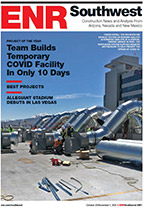Construction employment shrank for the second straight month in November as residential, nonresidential building and heavy construction segments remained in low gear, according to an analysis of new federal employment data released recently by the Associated General Contractors of America.
Association officials said the employment drop reflects continued declines in public-sector investments. They added that construction employment could benefit from increased transportation investments and other pro-growth measures designed to boost private-sector demand.
“Industry employment has remained virtually unchanged since early 2010 despite a pick-up in some private construction,” said Ken Simonson, the association’s chief economist. “Although the construction unemployment rate fell to 13.1% in November from 18.8% a year earlier, the lack of industry job growth means former construction workers are finding work elsewhere or leaving the workforce altogether. That’s ominous for future construction hiring.”
Total construction employment now stands at 5.52 million, down 12,000 or 0.2% from a month earlier and only 18,000 (0.3%) higher than in November 2010, the economist said. He noted that industry employment was actually 11,000 lower than in February 2010, while the private sector as a whole added nearly 3 million jobs in that time.
Residential building and specialty-trade contractors combined had no change in employment for the month but added 20,400 workers over the year, Simonson observed. Nonresidential building and specialty trade employment slipped by 4,700 in November but was unchanged year-over-year. Heavy and civil engineering construction—representing public works contractors—lost 7,000 jobs in November and 2,900 over the year.
Association officials warned that the decline in public works employment will intensify unless lawmakers promptly pass long-term highway and aviation spending bills that are now more than two years overdue. The construction trade association also urged passage of funding for water infrastructure and public buildings.
“Holding up these bills is forcing all levels of government to defer needed overhauls and improvements,” said Stephen E. Sandherr, the association’s chief executive officer. “The lack of funding is driving many workers out of the industry, perhaps permanently, and is making the eventual cost of infrastructure spending much higher.”


